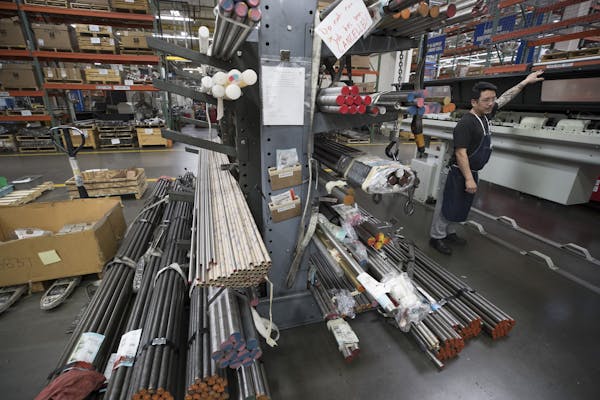Mines and logging companies are hiring, small businesses are expanding and Minnesota's Iron Range is bouncing back from the mine and production facility closures that hit hard just a few years ago.
A new state budget and economic forecast reflected positive news for the Iron Range, which added jobs in recent years and has seen a strong boost in iron ore exports, used to create steel. State budget officials credited tariffs on imported steel with helping bolster the local economy.
"A 5.2 percent increase in employment means a lot of money in the economy in northeastern Minnesota," said Kelsey Johnson, president of the Iron Mining Association of Minnesota. "It means that families are able to pay for their necessities and have a little bit of savings at home as well."
For President Donald Trump, it could also mean a political boost.
Minnesota's mining country was struggling in 2015 and 2016, when it couldn't compete with other countries' illegal dumping of low-priced steel. President Barack Obama responded with tariffs to combat the dumping, and Trump's administration imposed additional tariffs.
The president's tariffs have had varied impacts in different industries, and the new state forecast report by Minnesota Management and Budget notes that escalating trade rhetoric with China in 2018 hurt soybean farmers and led to the lowest soybean prices in a decade. But for Minnesota's iron ore industry, the tariffs on imported steel have been a boon.
Iron ore exports were up 42 percent in the third quarter of 2018 compared to the previous year, the forecast states.
That bodes well for Trump in 2020, said state Rep. Sandy Layman, R-Cohasset, who said voters on the Iron Range and elsewhere vote their pocketbook.
"Do they have a job? Do they have a paycheck? Are they doing better than they did last year? Those are the kinds of political decisions that are important to people when they go to the polls," Layman said. "Right now I think people are tying the turnaround and the strong economy to the current administration's policies."
State Sen. David Tomassoni, D-Chisholm, said he is concerned about the political shift in the area. In 2016, many of the northern Minnesota Senate seats held by Democrats flipped for Republicans. He sees frustrations "piling on" over state regulations and the delay of the proposed PolyMet copper nickel mine.
Many residents on the Iron Range, which has a long history of supporting Democrats and deep ties to labor unions, opted to support Trump in the last election. The president narrowly lost Minnesota in 2016, and northeastern Minnesota was a stronghold of support for him.
Thousands of supporters showed up for Trump's rally in Duluth in June. The president visited in part to offer support to then-congressional candidate Pete Stauber, who ended up taking control of the Eighth Congressional District seat that for decades has largely been held by Democrats.
During his Duluth visit, Trump highlighted the local effects of his trade policies at a roundtable that included members of the mining industry and local and national politicians. Johnson was one of the roundtable participants. She said her organization had a "very long and wonderful conversation" with the president and his staff about how important his actions have been for the vitality of the iron and steelmaking industries.
Iron Range Resources and Rehabilitation Board Commissioner Mark Phillips said the president's actions were helpful for the steel industry. But he said they were overkill for what steel workers needed and damaging to Minnesota's agricultural industry.
On the Iron Range, Phillips said the economic growth seems poised to continue for a variety of reasons. The catastrophic burst of another dam at an iron ore mine in Brazil increased ore prices worldwide. Minnesota communities are benefiting from that, he said, and predicted that they will likely continue to benefit for the next few years.
While signs for the future appear positive for the region, Tomassoni remained wary and said "the whole situation up here is tenuous at best." Complications and lawsuits over the controversial iron ore mine and processing facility project in Nashwauk are ongoing, he said, and the Hibbing Taconite mine could run out of iron ore in coming years. The PolyMet project is also in flux.
Many workers got some peace of mind last fall when Cleveland-Cliffs, one of the companies that operates a number of mining operations in the area, signed a four-year contract with union workers.
Nonetheless, Tomassoni responded to the positive February forecast numbers with his adage.
"When the steel industry gets a hiccup, the Iron Range gets the flu," Tomassoni said. "And we can change real quickly."
Olympic organizers unveil strategy for using artificial intelligence in sports

